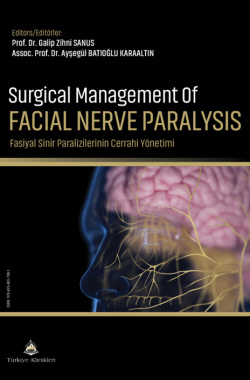Management of the Extratemporal Facial Nerve Injury
Mehmet Veli KARAALTINa, Ayşegül BATIOĞLU KARAALTINb
aNişantaşı University Health Vocational School, Department of Operation Room Services, İstanbul, Türkiye
bİstanbul University-Cerrahpaşa, Cerrahpaşa Faculty of Medicine, Department of Otolaryngology, İstanbul, Türkiye
Karaaltın MV, Batıoğlu Karaaltın A. Management of the extratemporal facial nerve injury. In: Sanus GZ, Batıoğlu Karaaltın A, eds. Surgical Management of Facial Nerve Paralysis. 1st ed. Ankara: Türkiye Klinikleri; 2022. p.123-6.
ABSTRACT
The surgical approach in peripheral facial nerve injury pertains a wide scope of knowledge and strategies relevant to the nature and, the level of the nerve injury. In this chapter, the authors describe unique surgical techniques utilizing the principles of microsurgery and functional anatomy. The chapter describes a unique method for harvesting the sural nerve flap. The authors describe the arterialized venous free sural nerve flap for large nerve defects relevant to the facial nerve injury. Finally, the authors describe a special method of using the Y sural nerve graft for facial nerve reconstruction.
Keywords: Facial nerve; sural nerve; microsurgery
Kaynak Göster
Referanslar
- Captier G, Canovas F, Boneel F, Seignarbieux F. Organization and microscopic anatomy of the adult human facial nerve: anatomical and histological basis for surgery. Plast Reconstr Surg. 2005;115(6):1457-65. [Crossref] [PubMed]
- Güerrissi jO, Miranda MFG. Intraneural topography of the extratemporal facial nerve: microsurgical nerve reconstruction. j Craniofac Surg.2007;18(3):578-85. [Crossref] [PubMed]
- Humphrey CD, Kriet jD. Nerve repair and cable grafting for facial paralysis Facial Plast Surg. 2008;24(2):170-6. [Crossref] [PubMed]
- Gu yD, Wu MM, Zheng yL, Li HR, xu yN. Arterialized venous free suralnerve grafting. Ann Plast Surg. 1985;15(4):332-9. [Crossref] [PubMed]
- Bullocks j, Naik B, Lee e, Hollier L jr. Flow‐through flaps: a review ofcurrent knowledge and a novel classification system. Microsurgery.2006;26(6):439-49. [Crossref] [PubMed]
- Vargel I. Impact of vascularization type on peripheral nerve microstructure. j Reconstr Microsurg. 2009;25(4):243-53. [Crossref] [PubMed]
- Kayalar M, Kucuk L, Sugun TS , Gurbuz y, Savran A , Kaplan I. Clinicalapplications of free arterialized venous flaps. j Plast Reconstr AesthetSurg. 2014;67(11):1548-56. [Crossref] [PubMed]
- Cakmak O, emre Ie. Surgical anatomy for extended facelift techniques.Facial Plast Surg. 2020;36(3):309-16. [Crossref] [PubMed]
- quatela V, Montague A, Manning jP, Antunes M. extended superficialmusculoaponeurotic system flap rhytidectomy. Facial Plast Surg ClinNorth Am. 2020;28(3):303-10. [Crossref] [PubMed]
- Marten Tj. High SMAS facelift: combined single flap lifting of the jawline, cheek, and midface. Clin Plast Surg. 2008;35(4):569-603. [Crossref] [PubMed]
- Wang RC, Barber Ae, Ditmyer M, Vantine P. Distal facial nerve exposure: a key to partial parotidectomy. Otolaryngol Head Neck Surg.2009;140(6):875-9. [Crossref] [PubMed]

